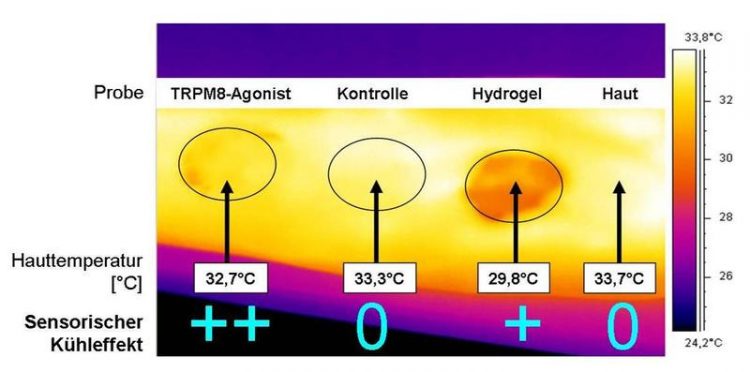Clothing with a sensory cooling effect / Development of textiles with a sensory cooling effect

Fig. 1: Thermogram of the underarm © Hohenstein Institute
As part of an IGF research project (AiF No. 18181 N), scientists at the Hohenstein Institute in Boennigheim have been developing and analysing a textile finish that provides a sensory cooling effect. Sensory cooling is the term used to describe a chemically induced sensation of coolness on the skin, due to the triggering of cold receptors in the nerve ends close to the surface of the skin. This is different from the cooling effect normally achieved by physical processes, where the skin is cooled mainly by the evaporation of water.
Targeted cooling of the surface of the skin is required, for example, when treating sports injuries, or after insect bites or for other therapeutic purposes (e.g. in the treatment of multiple sclerosis or psoriasis). Cold water, ice cubes, sprays and cooling, water-retaining medicaments can be used for this purpose. Cooling textiles made from high-tech fibres are also based partly on the principle of cooling by evaporation.
However, with commonly used cooling systems such as cool packs or ice sprays, the skin is often cooled down too much. In the worst cases, this can lead to symptoms of frost-bite and the formation of blisters which increase the damage to the skin. Unlike these conventional cooling methods, cold-inducing substances that result in “sensory cooling” have a mild cooling effect, even when spread over a large area, without over-cooling the skin. One example of this would be the peppermint substance “menthol”.
This has a cooling effect and soothes itching. Now a whole range of other chemical substances have been discovered which, like menthol, bind themselves to the cold receptors. These substances trigger a stronger cooling sensation, are odour-neutral and have a longer-lasting effect. This means they can be used for therapeutic purposes.
In their research project, the scientists at Hohenstein have, for the first time, developed a finish for textiles that creates a sensory cooling effect. This textile finish is based on p-menthane derivatives (agonists) such as WS-3 (N-ethyl-p-menthane-3-carboxamide) or L-menthyl lactate and icilin. These substances have the advantage that, when spread in very low concentrations on small areas of the body, they have a lasting mild cooling effect throughout their period of activity. This kind of sensory cooling textile finish was tested on different textile substrates made from natural or synthetic fibres and blends, and in concentrations of the active ingredient ranging from 0.1‰ – 1%.
In tests with volunteers, the attempts at functionalising textiles using substances which have a sensory cooling effect produced very different sensory perceptions of the degree of coolness. The sensory perception of cold depended not only on the area of skin being treated but also on a range of other parameters such as the moisture level in the skin and the topography of the skin surface. The way the perceived cooling effect on the skin is processed and assessed depends on numerous external and internal factors and is therefore subjective, i.e. each volunteer perceives the cooling effect in their own quite specific, individual way. During the project, the researchers were able to make new findings about the substance sensitivity of specific areas of the skin (e.g. the cleavage, underarm, soles of the feet). The project also showed that sensory cooling textiles are effective in textiles worn close to the skin, but are unsuitable for loosely cut clothing that is not in direct contact with the body.
At the end of the research project, the scientists at the Hohenstein Institute were able to show that applying a finish containing sensory cooling substances (WS-3 or menthyl lactate) would be feasible for SMEs. Following the positive results for textiles worn next to the skin, further investigations are likely to reveal new applications for therapeutic textiles.
For more information on this research project, please contact:
Christin Glöckner
Phone: +49 7143 271 445
E-mail: C.Gloeckner@hohenstein.de
http://www.hohenstein.de/en/inline/pressrelease_135488.xhtml
Media Contact
All latest news from the category: Materials Sciences
Materials management deals with the research, development, manufacturing and processing of raw and industrial materials. Key aspects here are biological and medical issues, which play an increasingly important role in this field.
innovations-report offers in-depth articles related to the development and application of materials and the structure and properties of new materials.
Newest articles

Properties of new materials for microchips
… can now be measured well. Reseachers of Delft University of Technology demonstrated measuring performance properties of ultrathin silicon membranes. Making ever smaller and more powerful chips requires new ultrathin…

Floating solar’s potential
… to support sustainable development by addressing climate, water, and energy goals holistically. A new study published this week in Nature Energy raises the potential for floating solar photovoltaics (FPV)…

Skyrmions move at record speeds
… a step towards the computing of the future. An international research team led by scientists from the CNRS1 has discovered that the magnetic nanobubbles2 known as skyrmions can be…





















